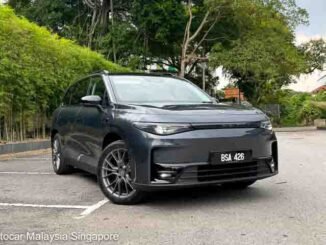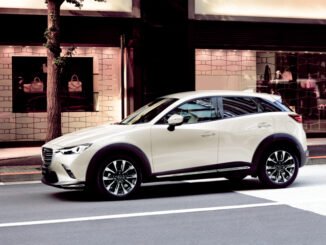
BYD Atto 3
![]()
Where Malaysia Price RM167,800 On sale now Engine permanent magnet synchronous motor Power 150kW/203bhp Torque 310Nm Gearbox single-speed Battery Capacity 60.5kWh Range 480km Kerb weight 1750kg Top speed N/A 0-100km/h 7.3sec CO2 zero Rivals Kona Electric, Nissan Leaf
What is it?
The BYD Atto 3 is an all-electric SUV from China. It is packed with lots of features and is the lowest priced all-electric SUV in the market at the time of review.
This is probably the car that I’ve been asked the most questions about. Some enquiries came from as far as the US and Australia. Total strangers came up to talk about it – something that has never happened with other cars.
No one had ever heard of BYD. Most surprising to them was that the car is from China, is all-electric and how reasonably priced it is considering how well specced it is.
The Atto 3 made a positive first impression during its launch test drive. Does it live up to that initial appeal on a more leisurely assessment?
What is it like?
To recap, the Atto 3 looks contemporary but unremarkable, in a good way. The most striking details are the burnished metal strip on the bonnet with “BYD”, the words “Build Your Dreams” emblazoned across the tailgate and the textured aluminium panel on the C-pillar. It’s good-looking enough to warrant second looks but nothing so experimental to attract ugly stares.
Size-wise, its overall length is 4455mm – between the Honda HR-V and Honda CR-V which are 4340mm and 4623mm respectively.
Build-wise, the car feels substantial. There is a solid sounding ‘thunk!’ when the doors close. There are some slightly uneven shutlines and panel gaps but these are only obvious under close inspection. We emphasise “close” because most people wouldn’t notice – or care. However, BYD is an unknown brand entering the market which warrants our scrutiny. Most substantive the Atto 3 is Euro NCAP Five Star safety rated.
The specs list is extensive, filled with features that get car buyers nodding their heads enthusiastically: LED front and rear illuminations, ambient lighting, panoramic sunroof, electric tailgate, USB-C and -A ports, electric tailgate, 360º camera, V2L (of which, more later), Dirac HD eight-speaker sound system, wireless phone charging, CN95 and PM 2.5 air filters. The list of safety and driver assistance features is also long. Fortunately, we didn’t test any.
It’s electric so there is no engine noise nor resulting vibration. However, there is no escaping tyre noise or body shake when going over uneven surfaces. The cabin and the soft-touch plastics of the interior surfaces mitigated against most exterior noise intrusion and absorbed vibration which makes the Atto 3 very smooth as well as soothing to drive. The steering feedback – electronically controlled and adjustable – is reassuringly heavy at speed but highly manoeuvrable at low speeds. The 201 horsepower motor is dauntless. Fully-laden, with adults after a substantial lunch, the Atto 3 felt no heavier than when I was driving alone. The ice-cream van tinkling sounds noted during the launch drive is, fortunately, an option that can be switched off.
A few days in, we decided to try out voice commands, activated by calling out “Hi, BYD!”. We are not fans of voice assistants which can be intrusive and distracting. In one car we reviewed, the voice assistant talked randomly and would bellow “drive slowly!” even thought I was below the speed limit. This only happened when I was alone in the car, at night. Can a learning algorithm acquire PTSD?
However, the BYD assistant was useful because the window buttons on the door were not comfortably within fingertip range. In fact, they were so far out of reach that many times, intending to open the front windows, we got the rear windows going down instead. For that, the BYD assistant was more convenient and less distracting as there was less fumbling about. The other switches and buttons were located where expected with the most commonly used clustered around the gear lever.
One curiosity… China is a left-hand drive country but the Atto 3 indicator stalk is on the right, Japanese-style, with the wipers on the left-hand stalk. A random thought… with electronics and customisation options, why haven’t car manufacturers made it possible for drivers to customise the side they’d prefer their indicators on?
The grey, black, dark blue and vermillion guitar-inspired interior seemed so gaudy at the launch. Now the colours were more harmonious on the eye. The undulating lines and textured surfaces still look and feel attractively tactile. A bit too enticingly tactile perhaps, in the case of the interior door handles, a curved plate on top of the speakers. Two different people ran their fingers along the ridged top surface then tried to slide it back, not realising their function. Fortunately, the auto-lock had already engaged.
The bucket-style, multi-way power-adjustable front seats are as we remembered: well-bolstered with good body support. This time, we had time to check out the rear seats too. There is a lot of leg room for passengers because there’s no transmission tunnel. In addition, the verdict was from someone with long term back pain from a slipped disc: the back rest was a comfortable angle with good thigh support. The matt synthetic leather upholstery feels comfortable against the skin – it does not get sweaty or sticky.
So, what did we like and dislike about the BYD Atto 3? For “Like”, the huge infotainment screen which adjusts the display automatically as it rotates from landscape or portrait. If it’s portrait, the monitor flips to landscape when you switch off the car so it’s less conspicuous while parked. If rotates back when the car is restarted. The large display area also made it easier to see the details captured by 360 camera.
Another thumbs up too for the compact instrument cluster. Small but a lot of relevant information which is easy to grasp at a glance. The range is also displayed in kilometres which is more relatable than a battery percentage – 40km is less worrying than 10% battery remaining.
Another favourite was the 360-degree camera and the multiple side angles it captures. That combined with the tiny turning circle made the Atto 3 a joy to park.
Finally, we didn’t try this out but the Atto 3 has Vehicle-to-load (V2L) charging. V2L is a bidirectional power feature that enables the EV battery to power anything that uses a domestic 3-pin socket, including another EV. What you do with that is only limited by your imagination. It’s a mobile generator. You can set a limit so you don’t drain the battery and can’t get home. Other EVs in Malaysia currently with this feature are the Ioniq 5 and the Kia EV6.
We only had three serious irks. First, there was only one keyless entry sensor, on the driver’s door. Second, the window switch placement mentioned before. Third, that the car isn’t all-wheel drive because of the torque it is capable of generating. Presumably this was a decision based on consumption efficiency. A fourth point, though not a “serious” irk but should be noted, the Atto 3 does not follow the PRNDL gearshift convention with the P being a separate button located at the base of the gear stalk.
Should I get one?
Lowest cost EV SUV in the market, looks, features and an eight-year battery warranty – if you really want to get on to the EV ladder, the BYD Atto 3 is a good start. We would recommend the Extended Range version we reviewed over the RM149,800 Standard because bigger is better, if you can afford it. The 70 extra kilometres makes outstation travel more feasible as does the faster DC charging rate (80kW compared to 70kW on the Standard), plus a few additional convenience features.
The biggest advantage of the Atto 3 is its Blade Battery. It’s proprietary to BYD. BYD claims the Blade Battery pack has a life span of 3,000+ charge cycles, or the equivalent of driving 1.2million kilometres without needing to replace the battery. In comparison, Tesla batteries typically need to be replaced after around 320,000 to 480,000 kilometres. Tesla is installing Blade Batteries in their latest cars.
The Atto 3 Extended Range’s EV rivals are the Hyundai Kona, the top-of-the range Electric e-Max variant, and the Nissan Leaf. The Kona Electric e-Max is RM199,888 while the Leaf is RM168,888. The Leaf’s range is 270km, the Kona Electric e-Max’s 484km with a maximum torque of 395Nm, making it more powerful than the Atto 3. The maximum charging rates for the e-Max is 11kW (AC) and 100kW (DC) vs the Atto 3’s 7kW and 80kW respectively. Whether that justifies paying almost RM33k more for the Hyundai depends on how badly you don’t want a China-made car.





































